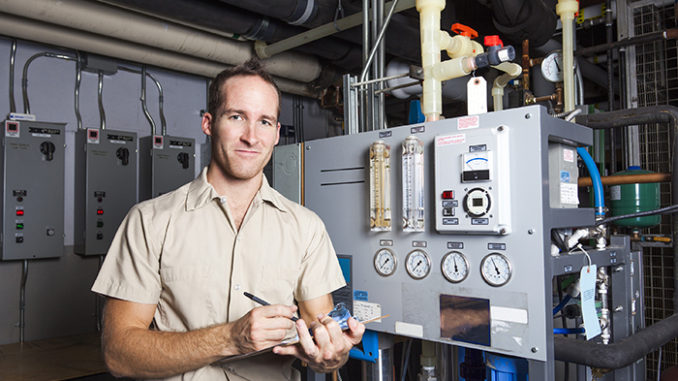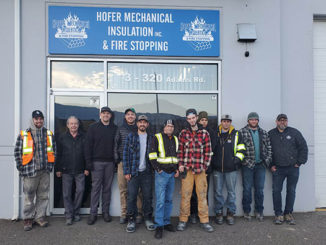
As building occupation lowered in response to COVID-19, opportunities for building retrofitting and maintenance are on the rise.
By / Jessica Kirby
Working from home is a lot like blue cheese dressing, trigonometry, and Stephen Segal movies—you’re either a raging fan or you most definitely are not, and no one can convince you otherwise. Even before COVID-19, people with experience working from home and in the office had pledged allegiance to their favourite side of this conundrum, and since the pandemic exposed more than 70 percent of working Canadians to how productive a laptop at the kitchen table can be, there are even more people who know exactly where they stand on this matter.
A year ago, commercial property owners were confident that, like in other periods of recessionary decline, the rumours that working from home was here to stay were false and that once the novelty wore off people would pile gratefully back into their cubicles, excited to see their colleagues and take the elevator—rather than the obstacle course through Lego and Cheerios on the carpet—to get to work.
Not so. Although historically Canada has seen circumstances that relegate people to their home offices and where they can’t wait to get back to work, those people weren’t tech-savvy, destiny-forging, work-life balance seeking Gen Xers, Millennials, and Gen Zers, all of whom score high on the polls querying whether they would rather look out the living room window than the corner office window on their lunch breaks. According to Gallup, the majority of remote workers are Millennials: 52 percent, versus 29 percent of Gen Xers and 17 percent of Baby Boomers; almost half of all Millennial employees (46%) work from home, and a whopping 74 percent of them do not want to go back to the office five days a week.
Just in the past 12 months, studies suggest permanent remote work positions have increased from 8 percent to 35 percent in Canada and the United States, and approximately 35-40 percent of jobs in both countries can be done from home. Most interesting is that a survey of 5,221 professionals in 31 countries working remotely during the pandemic said that 77 percent reported being equally or more effective at home than working at the office and 86 percent said they intended to continue with it in some form post-pandemic.
So what does that mean for commercial property in urban centres? According to an article in McKinsey titled, “Commercial real estate must do more than merely adapt to coronavirus,” physical distancing has “directly changed the way people inhabit and interact with physical space, and the knock-on effects of the virus outbreak have made the demand for many types of space go down, perhaps for the first time in modern memory… Real estate owners and operators across almost every asset class are considering several potential longer-term effects of the coronavirus outbreak and the required changes that these shifts are likely to bring.”
These changes could include a reversal of the trend towards densification and open plan layouts and, most importantly, “public-health officials may increasingly amend building codes to limit the risk of future pandemics, potentially affecting standards for HVAC, square footage per person, and amount of enclosed space,” the article says.
If we look to the history of disruption, it is companies who fail to innovate that are the first to go down with the ship (think Blackberry). That means shifts in how we work don’t mean the end of the line for commercial property owners; rather, the trend has important implications for how commercial property owners will have to innovate to stay competitive and, most importantly, it opens up essential opportunities for energy efficiency and retrofitting work. And rest assured, it will be the Steve Jobs’ of real estate who will grasp this shift as an important and sustainable opportunity.
Retrofitting is a major market for Canadian construction firms, particularly those with an energy efficiency mandate. In fact, as the remote workforce opens the spaces, leaving a vacuum only innovation can fill, the demand for energy efficiency and improved indoor air quality is on the rise. Even those working from are forwarding the cause because they are innately more aware of whether buildings are too warm, too hot, have poor air quality, or lack proper ventilation, and they are going to bring that awareness back to their workplaces. “These concerns present a window of opportunity to increase energy efficiency and reduce emissions while giving people the healthier and more comfortable buildings they want,” says the International Institute of Sustainable Development (IISD).
Fuelling the trend are important energy efficiency goals in Canada, which are supported by government funding and international attention to climate change. At the moment, residential efficiency programs in Canada are achieving energy savings of about 10–20 percent through things like air fixture replacements, lighting upgrades, draft protection, and smart technologies, but meeting ambitious energy goals requires savings closer to 30–50 percent, which venture into building envelope upgrades and heat pump territory.
So far, Canada is doing a so-so job of meeting its ambitious energy goals, and the momentum is only rising. Brendan Haley, Policy Director at Efficiency Canada, told the IISD that his organization just released its second scorecard of provincial energy efficiency policies at the end of 2020, and British Columbia received top marks thanks to initiatives like the Energy Step Code, while Prince Edward Island led in overall energy-efficiency programs, particularly, program spending for low-income and Indigenous People. But let’s not get ahead of ourselves. Even Canada’s energy rockstars fell behind some of top achievers in the United States, such as Massachusetts, California, and Vermont.
Last year, Canada joined other government agencies, such as the UN Environmental Programme and the European Bank for Reconstruction and Development, to become part of the Three Percent Club, which it committed to achieving three percent global annual improvements in energy intensity—the level the International Energy Agency says is needed to meet the Paris climate commitments. Historically, Canada improves its energy efficiency by about one percent a year, which means its efforts need to triple.
But there is hope. According to the Canada Green Building Council’s report, “A Roadmap for Retrofits in Canada” existing buildings play a critical role in realizing Canada’s low carbon future. The report provides recommendations to retrofit large buildings that will contribute to achieving a reduction in GHG emissions of at least 30 percent (or 12.5 million tonnes) by 2030, with the potential to reach 51 percent or 21.2 million tonnes.
If we are going to turn the COVID lemon into lemonade for future generations, efforts to mitigate climate change have to meet savings goals and foster a quicker, more productive process for building retrofits—and we have a short window in which to launch this lofty goal. Being more productive doesn’t mean slashing budgets and “cheaping out”; it means leveraging innovations in logistics, financing, manufacturing, and service to increase the value for building owners.
It means leveraging technology and innovations that foster productivity and more stringent building codes while mitigating the challenges presented by Canada’s diverse regional contexts. And achieving that may start with a commitment to doing energy retrofits at the kind of large scale—a scale made possible by important shifts in how and where people do their work—that allows the development of a more integrated, streamlined approach to energy saving retrofits.
Haley feels hopeful about the Canada Infrastructure Bank’s growth plan, which has the potential to spur the creation of a financial market for energy retrofits on both larger buildings and for residential homes, and incite exploration of new ways to retrofit buildings to improve energy efficiency at the scale and speed required.
The ultimate goal? Lasting, sustainable changes that drive momentum and boost efficiency standards until all provinces commit to making all new buildings net-zero and energy-ready.
In Policy Options, Haley calls for an increase to the scale and scope of existing efficiency program portfolios in the leading North American jurisdictions to create “a ‛shovel-ready’ and ‛shovel-worthy’ economic stimulus initiative, with the ability to create 175,000 annual jobs and increase annual GDP by $42.5 billion.
“To build a net-zero emissions economy, we need to dramatically expand the number of deep retrofits in a year,” Haley says. “This means innovations in program strategies, business models, and efforts to mobilize finance. We must figure out how to move from incremental one-by-one projects toward a systemized approach that is able to achieve economies of scale. In the process, our markets will be transformed so the most efficient products and designs—the ones that maximize our comfort and save us the most energy—become the norm, rather than the exception.”



